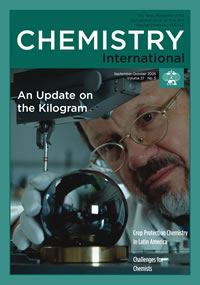|
|
Vol.
33 No. 3
May-June 2011
by Ian Mills
On 24 and 25 January 2011 a discussion meeting was held at the Royal Society of London. It was prompted by the upcoming presentation by the International Committee on Weights and Measures (CIPM) of a significant revision to the way in which the International System of Units, or SI, is defined and presented, for discussion and approval by the General Council on Weights and Measures (CGPM) at its meeting in Paris in October 2011.1 The General Council is the controlling body for the approval of any changes to the SI. The Royal Society meeting was held to bring attention to these plans for revision so that they can be widely discussed before the General Council meets.
 |
| In this Sep.-Oct. 2005 CI cover, master optician Achim Leistner checks on an Avogadro’s sphere. Such a perfectly spherical single crystal of silicon is needed for the X-ray crystal density experiment relevant to one of the proposed alternative definitions of the kilogram. (Image courtesy of CSIRO Industrial Physics, Lindfield NSW, Australia.) |
The proposed changes to the SI are prompted by the need to adopt a new definition for the kilogram, which has been under discussion for many years. This need arises from our knowledge that the International Prototype of the Kilogram (kept in a safe at the Bureau International des Poids et Mesures at Sèvres), which is the present definition of the kilogram, is slowly changing in mass. The change is on the order of 50 micrograms or more over the last century; the change is not known exactly, although it is two orders of magnitude larger than the uncertainty with which kilogram masses may be compared. We do not even know whether it is getting heavier or lighter, because we have no absolute reference with which to compare it. The change is believed to be due to surface chemistry, wear and tear, and possibly gas leaching out of the platinum-iridium prototype trapped within it when it was cast.
The recommendation from CIPM is to adopt new definitions for four of the base units of the SI, relating them to the fundamental constants of physics. It is proposed that the kilogram, ampere, kelvin, and mole should be referenced to fixed numerical values of the Planck constant h, elementary charge e, Boltzmann constant k, and Avogadro constant NA, respectively (just as the metre was redefined in 1983, referenced to a fixed numerical value of the speed of light in vacuum). The new definitions would be adjusted to preserve continuity with the previous definitions of the units. It is also proposed that the entire SI be presented in a revised format. This will be the most significant revision to the SI since it was established.
If the General Council approves these plans it is still likely to be several more years before the proposed changes are actually adopted, because new experimental results on the value of the Planck constant to be used in the definition are expected in the near future from watt balance and silicon crystal density experiments currently in progress.
At the Royal Society meeting there were 16 presentations from leaders in the field of metrology, including three Nobel Prize winners, followed by vigorous discussion from the 200 or so participants, who came from many different countries. The presentations covered both the underlying theoretical physics involved as well as recent experimental developments in the watt balance, the X-ray crystal density experiment using a silicon 28 sphere, new measurements of the Boltzmann constant, the use of ultra-cold atoms in precise time measurements, radiometric measurements from space, and units for biological quantities. There were also fascinating discussions of the history of our developing units of measurement.
Of particular interest to chemists was a paper on the Avogadro constant, and the proposal for a new definition of the mole in terms of a fixed numerical value of NA, which would fix the mole in terms of a fixed specified number of entities. All of the papers and the discussion at the meeting will be published later this year in a special issue of the Philosophical Transactions of the Royal Society devoted to a report of the meeting.
References
See BIPM 2010, Resolution A for the CGPM, On the Possible Future Revision of the International System of Units, the SI. Available on the website of the BIPM <www.bipm.org/utils/common/pdf/
24_CGPM_Convocation_Draft_Resolution_A.pdf>. See also <www.bipm.org/cc/CCU/Allowed/20/
Watermark_SI_Brochure_Draft_Ch2_29Sep10.pdf>.
Ian Mills <[email protected]> is a professor at the School of Chemistry, University of Reading, Reading, UK. He is IUPAC Representative on BIPM-Consultative Committee on Units (BIPM/CCU) and ISO—Technical committee on Quantities and units (TC 12).
Page
last modified 9 May 2011.
Copyright © 2003-2011 International Union of Pure and Applied Chemistry.
Questions regarding the website, please contact [email protected] |